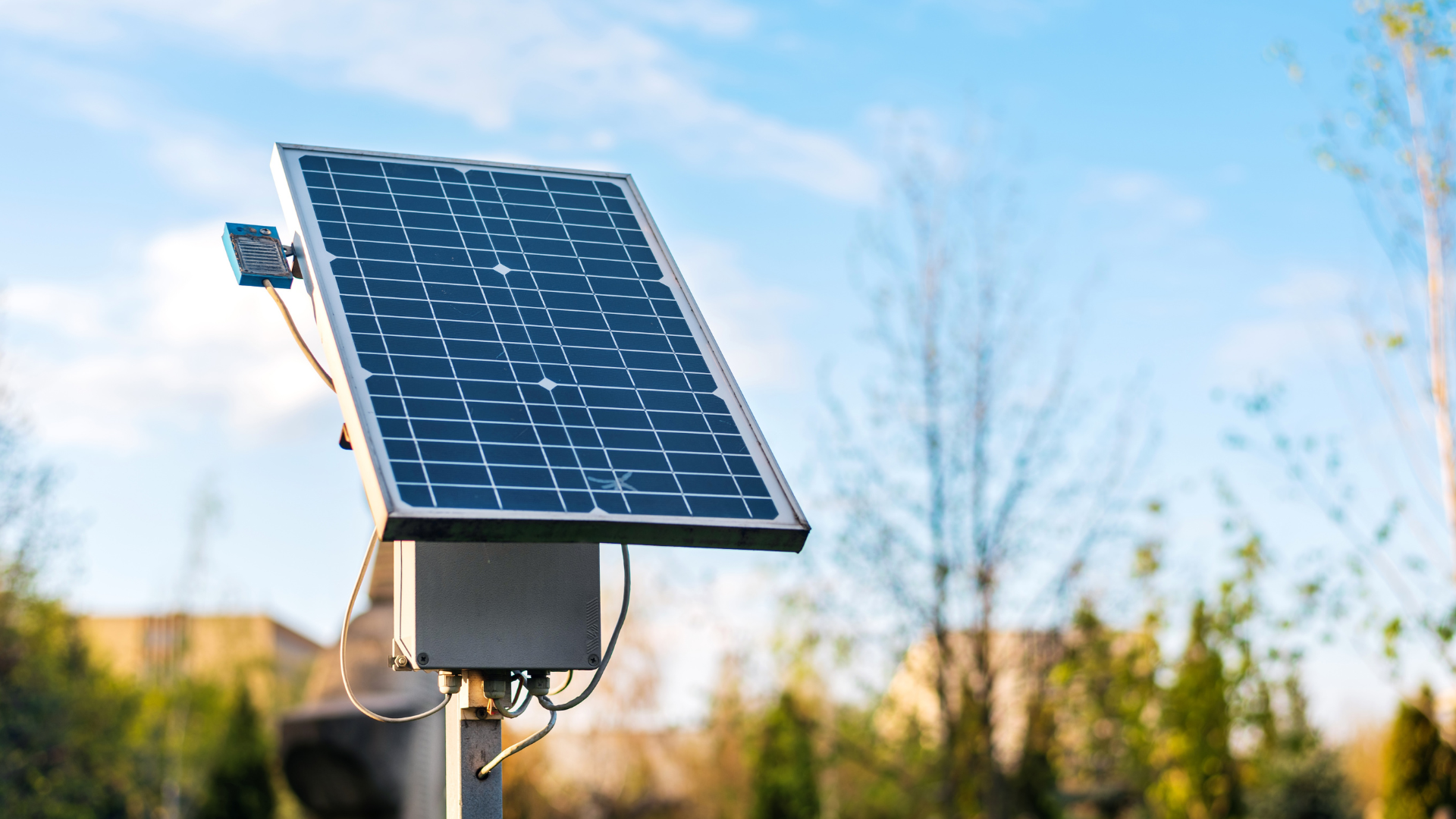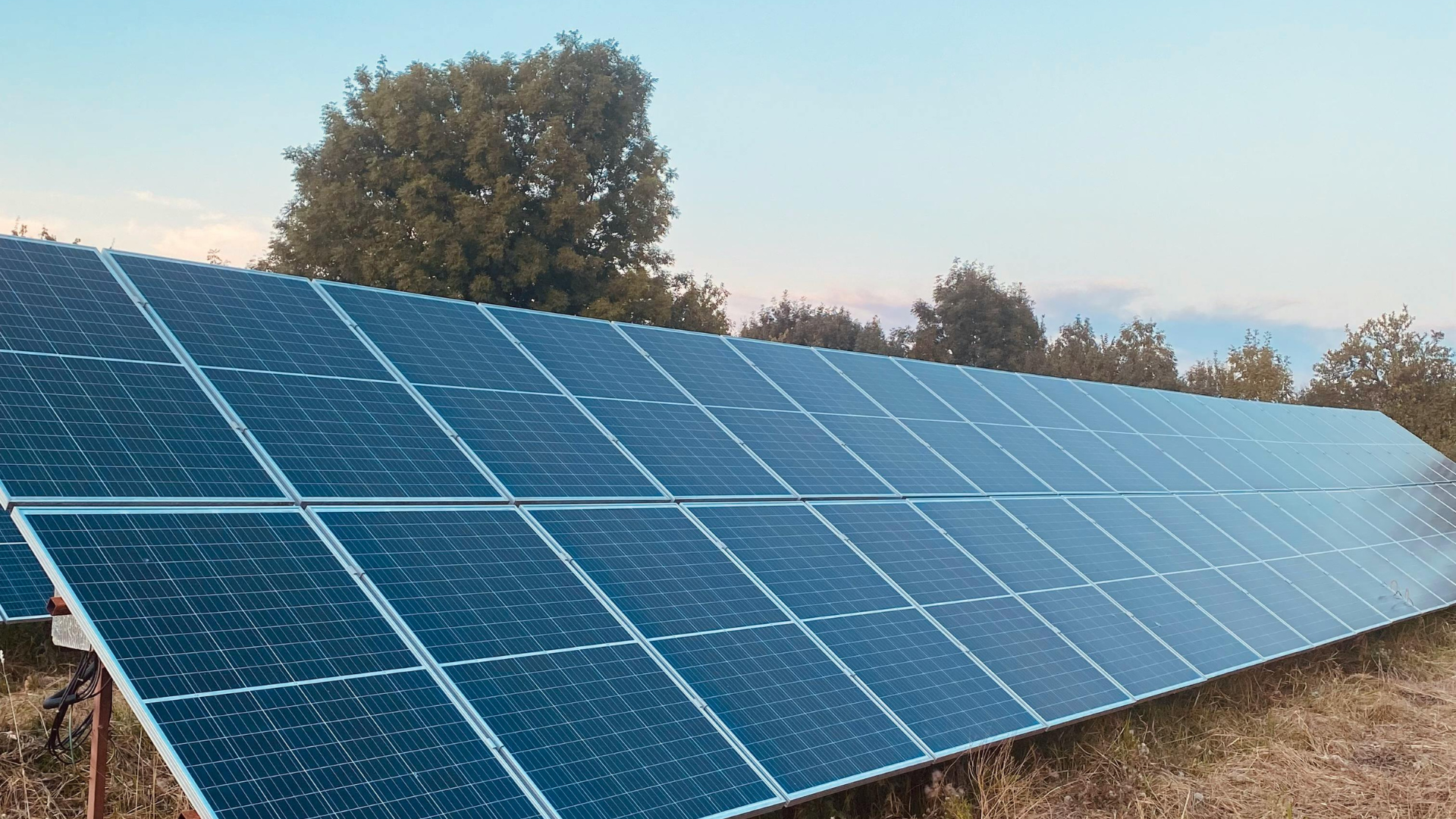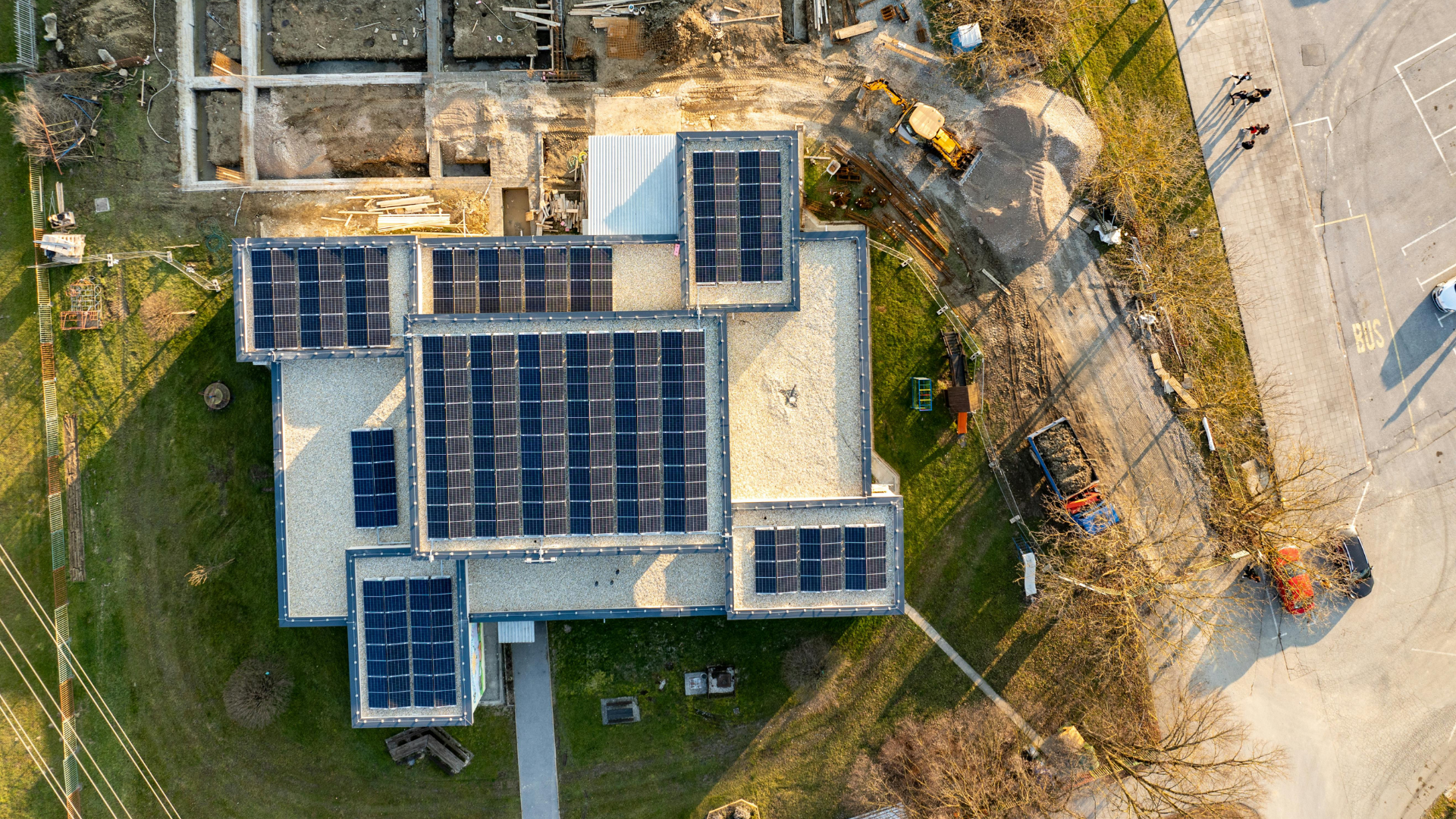November 20, 2025
Audio overview: Listen & Learn
Solar quotes can feel like a puzzle, a mix of numbers, equipment specs, and incentives that don’t quite line up from one installer to another.
You see one company highlighting efficiency, another focusing on savings or upfront costs, and it's hard to compare solar quotes when you don't know what's accurate and what's just marketing.
Behind every quote, though, are clear factors that shape pricing: your solar system design, roof space, and energy needs.
Add in state rebates, solar loan options, and brand differences, and you can see why confusion is common, even for people committed to clean energy.
As more solar companies compete for attention, transparency matters more than ever. Understanding what’s inside each proposal helps customers find local installers, get the best deal, and stay protected long after their system is installed.
Understanding Your Solar Quote: What’s Included, What Affects Cost, and How to Compare Offers
A solar quote shows more than just the price tag; it shows a snapshot of your entire solar journey, showing how system size, equipment, and incentives come together.
In this guide, we’ll unpack every part of the quote so you can spot value, compare offers from local installers, and choose the setup that powers your home efficiently for years.
Key Takeaways
- A solar quote provides a full breakdown of your system design, materials, incentives, and projected savings.
- Understanding each component helps you compare quotes accurately and avoid inflated or misleading estimates.
- Factors such as system size, location, energy usage, and financing options can significantly affect total cost.
- Clear, transparent quotes build buyer confidence and help solar installers establish long-term trust with customers.
Turn your next solar quote into a clear decision.
With Sunbase, you can instantly see how system size, incentives, and equipment choices affect total cost and ROI — no more guesswork. Explore how Sunbase simplifies solar quoting.
What Is a Solar Quote (and Why It Matters)
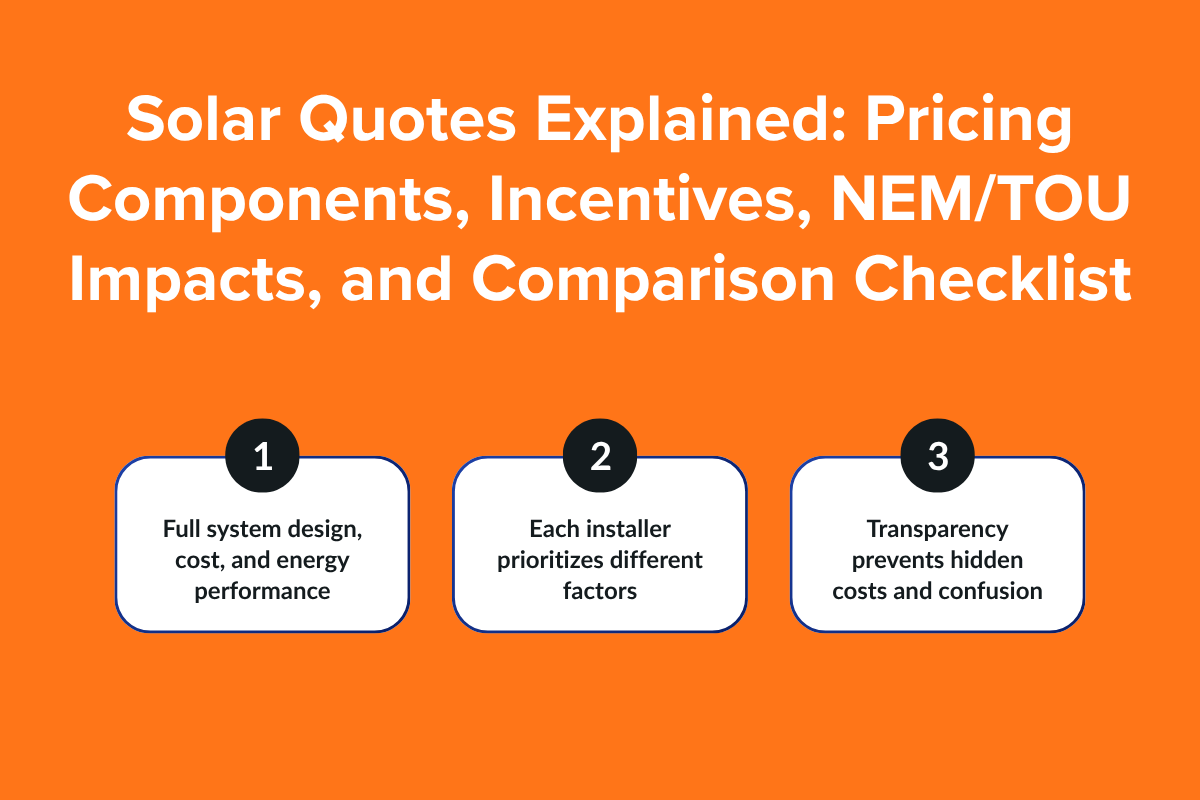
A solar quote is a detailed proposal outlining your system design, costs, and expected energy performance, essentially the project’s blueprint.
It combines technical details like panel type, inverter capacity, and layout with labor costs, local incentives, and estimated energy generation.
The challenge is that no two solar quotes follow the same logic. Each installer prioritizes different factors: some emphasize premium equipment and long-term output, while others focus on short-term affordability or flexible financing. That’s why two proposals for the same home can look completely different.
A well-structured quote reveals how efficiently your system is planned, how reliable the components are, and what kind of value you can expect over time.
Transparency at this stage prevents costly surprises later, from inflated installation fees to unrealistic production estimates.
Next, we’ll unpack each part of a quote to show where your money goes and how those choices affect system performance and payback.
Main Components of a Solar Quote
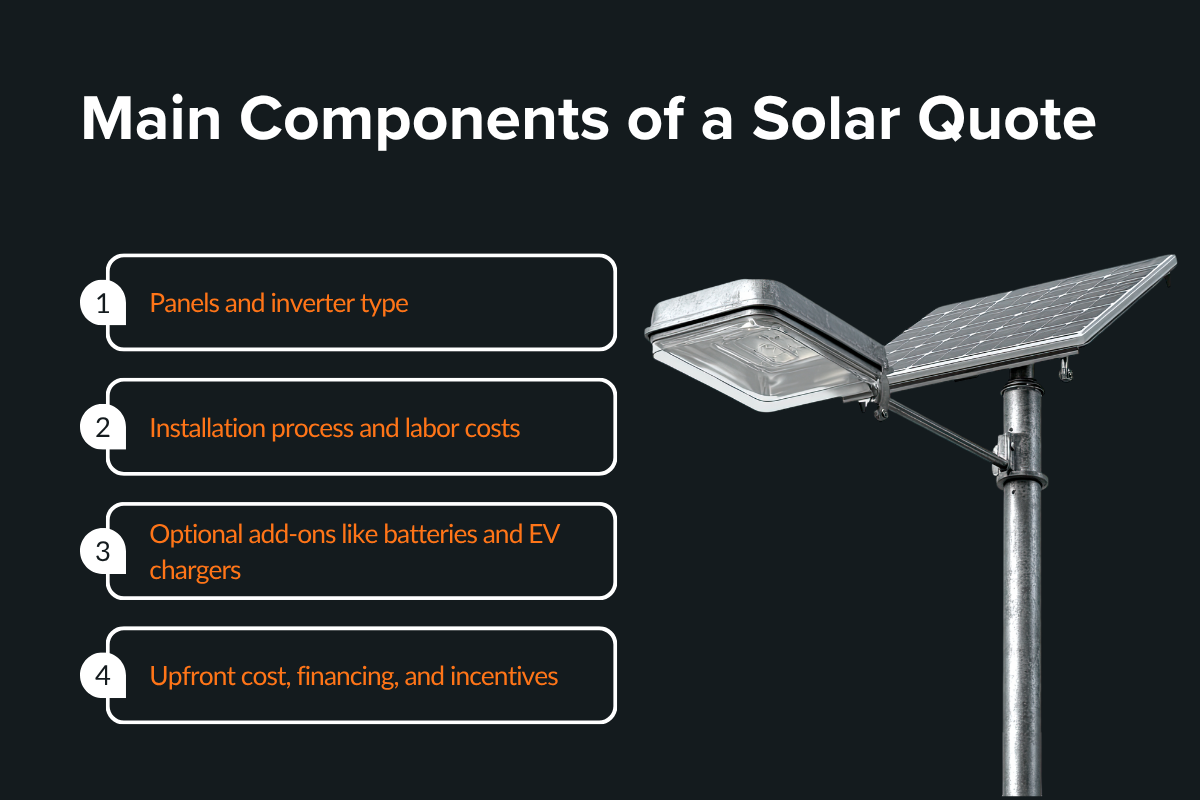
A well-prepared solar quote should clearly outline what’s being installed, how it performs, and what each element contributes to the total cost.
While layouts, brands, and pricing vary by installer, every quote generally includes four core sections that define the system’s value and performance.
1. Solar Panels and Inverter Type
This is where most of your investment goes: the panels and the inverter that converts direct current (DC) from sunlight into usable electricity for your home.
A) Panel Specifications
Most quotes include:
- Brand and model (e.g., Qcells, REC, Longi)
- Watt rating: typically 400W to 450W per panel
- Efficiency percentage: how well panels convert sunlight into power
Premium panels perform better in partial shade or limited roof space but cost more upfront. Standard panels are budget-friendly but slightly less efficient in non-ideal conditions, such as low light or heat.
Also read: Advancements in Solar Design Software: What’s New in 2025
B) Inverter Type
The inverter determines how your system converts energy:
- String inverters handle multiple panels together, which is cost-effective, but a single shaded panel can reduce overall output.
- Microinverters manage each panel individually, pricier, but ideal for complex roofs or uneven sunlight.
Tip: When comparing quotes, check which inverter type is included and how it supports your roof layout, shading, and long-term performance goals.
2. Installation Process and Labor Costs
Labor accounts for roughly 10–20% of your total project cost, and it’s where quality truly matters.
A) What Certified Solar Installers Include:
A transparent quote should clearly cover:
- Site assessment and roof inspection
- System design and permitting
- Electrical work and grid interconnection
- Equipment setup and testing
- Labor and workmanship warranties
These steps ensure your system is installed safely and complies with local regulations. Quotes missing these details may hide future expenses.
B) Warranty and Aftercare
Strong quotes specify both equipment warranties (20–25 years for panels) and labor warranties (5–10 years). This gives you clear protection against performance or installation issues.
3. Additional Equipment and EV Charging
Modern solar systems often extend beyond panels and inverters. Most quotes now include optional upgrades that add capability or resilience.
- Battery Storage: Stores excess energy for nighttime or backup use. It increases independence from the grid and improves system reliability during outages.
- EV Charging: Integrates an electric-vehicle charger directly into your system so you can power your car with solar energy. Ask that it be itemized separately to see its effect on the total cost.
- Home Electrification Upgrades: Some installers bundle smart monitoring devices or load-management tools. These devices optimize how your solar system powers the rest of your home.
Why It Matters: Each add-on raises the initial quote but can reduce reliance on the grid, improve long-term savings, and support future energy needs.
Tip: If your quote includes these items, make sure they’re clearly itemized so you can see their exact impact on total costs and ROI.
4. Upfront Cost vs Financing Options
How you pay for your system shapes your total return on investment. Every quote should clearly explain payment structures and available incentives.
A) Common Payment Models
- Cash purchase: Highest upfront cost, full ownership, best long-term returns.
- Solar loan: Pay monthly, still eligible for tax credits and rebates.
- Lease or PPA: Low upfront cost, but the installer retains ownership and incentives.
B) Incentives and Rebates:
Look for credits like the 30% federal tax credit or state-level rebates. These reduce your overall payback time.
The quote should show them as separate line items so you can see their real impact.
C) What to Look For:
A professional quote breaks down:
- Gross system cost
- Incentive or rebate amounts
- Final customer cost after incentives
- Expected energy savings and payback timeline
When these numbers are clear, it’s easy to understand both the upfront cost and the lifetime value.
How Solar Pricing Is Calculated (and Why Quotes Differ)
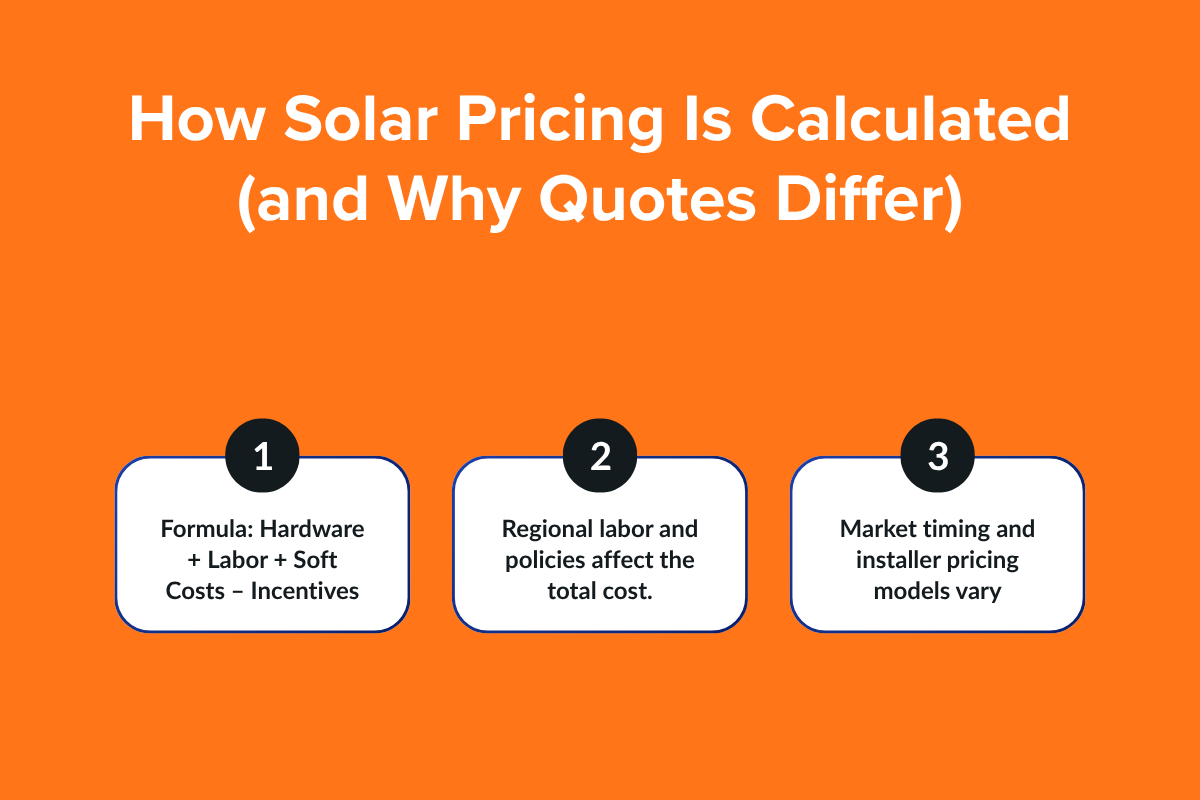
Two homeowners can request solar quotes for the same-sized roof and still get completely different numbers.
That’s because every installer uses a slightly different pricing model, shaped by system design, operating costs, and regional policies. Here’s how pricing actually works behind the scenes.
1. The Core Formula
Every solar quote is built around the same equation:
Total System Cost = Hardware + Labor + Soft Costs – Incentives
- Hardware includes panels, inverters, batteries, and mounting gear.
- Labor covers installation, wiring, and inspections.
- Soft costs include permits, logistics, marketing, and customer acquisition.
Even small variations in these inputs, like panel brand or permit requirements, can swing total pricing by thousands.
2. Regional and Market Differences
Solar pricing changes city to city. Labor rates, permitting rules, and incentive availability all shift the final cost.
- Dense urban areas often face higher labor and compliance fees.
- Rural zones may save on logistics but lose access to local rebates.
- Some states with mature solar programs price 20–30% lower due to competition and standardized interconnection.
3. Timing and Supply Fluctuations
Solar hardware prices move with global supply.
- Panel shortages or currency shifts can raise equipment costs temporarily.
- Seasonal demand spikes (before fiscal-year deadlines or policy changes) often push installer pricing upward.
A well-documented quote will note material validity, typically 15–30 days, to protect against these market shifts.
4. Different Pricing Models by Installers
Not every installer calculates cost the same way:
- Some quote per kW installed, a transparent cost-per-capacity model.
- Others bundle hardware, installation, and warranty into a single package price.
- A few add profit margins based on customer financing or add-ons.
Understanding which model your installer uses is key to making an apples-to-apples comparison.
5. The Role of Transparency Software
Modern quoting platforms now standardize these inputs for solar installers and customers. They automatically pull in equipment data, incentive eligibility, and labor estimates, creating consistent, transparent pricing logic across regions.
This shift is what makes today’s solar quotes far more reliable than they were even a few years ago. You can see the full breakdown, validate the assumptions, and make decisions confidently.
Also read: Guide on How to Quote for Solar Panels
What are Incentives, NEM, and TOU Impacts
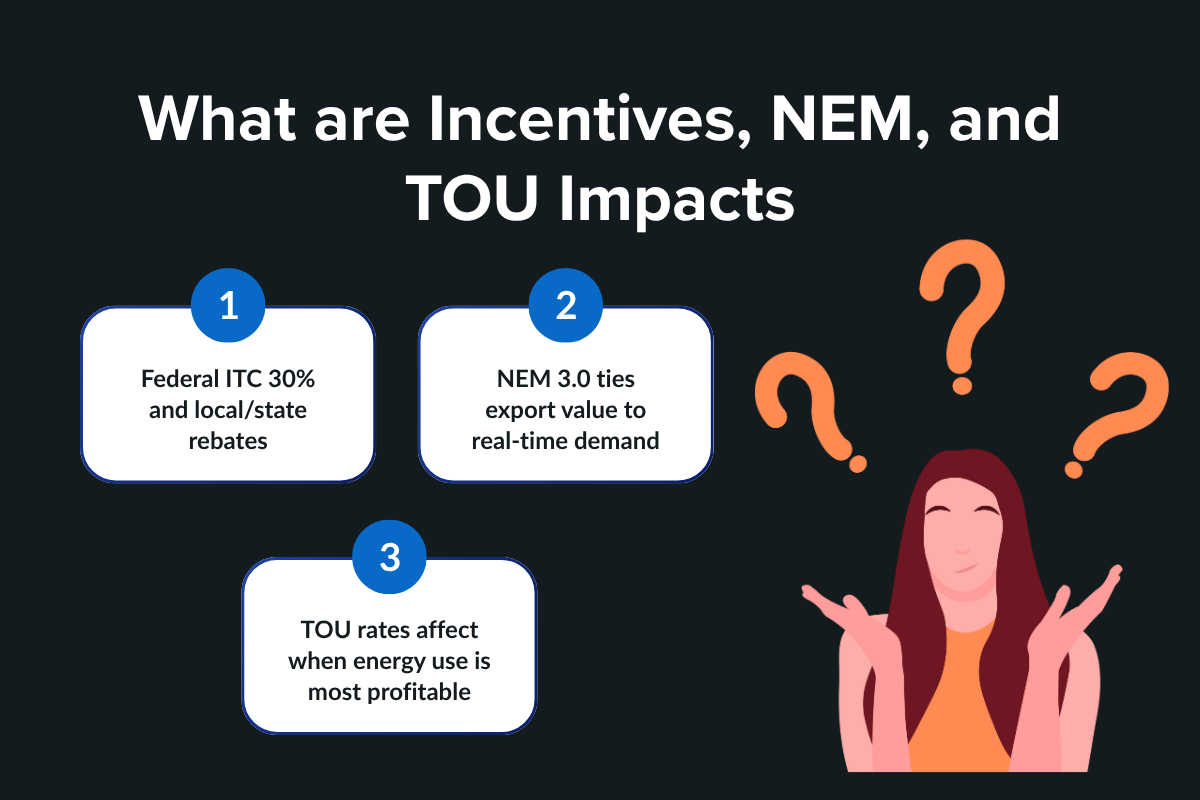
Incentives and energy policies can change the financial outcome of a solar project just as much as equipment choices do. They determine how fast you recover your investment and why two identical systems can have completely different payback periods.
1. Federal and State Incentives
Government incentives directly lower the upfront cost of a solar installation.
- Federal Investment Tax Credit (ITC): Covers up to 30% of system cost, including labor and equipment.
- State or local rebates: Vary by region and may add 5–15% in savings.
- Solar loans: Some lenders integrate these credits into your payment plan, reducing early-year pressure.
Quotes that clearly show these credits separately (not baked into the base price) make comparison more accurate and transparent.
2. Net Energy Metering (NEM 3.0)
Net metering lets you earn credits for the electricity your panels send back to the grid. Under NEM 3.0, introduced in several states, the value of exported power is now tied to real-time grid demand.
What this means:
- Daytime export credits are lower than before, since solar supply is high.
- Evening credits are worth more because grid demand peaks.
- Systems with battery storage can time their exports to capture better rates.
Good quotes model NEM assumptions clearly, showing how much you’ll earn under the new structure and how batteries affect ROI.
3. Time-of-Use (TOU) Rates
With TOU billing, your electricity price changes throughout the day. Using stored solar energy during peak hours directly improves payback.
Look for quotes that:
- Simulate consumption using TOU rates from your utility
- Show savings with and without battery storage
- Highlight the payback period under multiple rate scenarios
Quotes without TOU modeling often underestimate your actual long-term savings.
4. Why This Section Matters
Most homeowners compare quotes only by total cost. But incentives, NEM, and TOU collectively shape your solar system’s performance and financial return. Transparent quotes reflect real-world policy, not ideal assumptions, and that’s what separates an accurate proposal from a marketing pitch.
Next, we’ll look at how to compare solar quotes fairly, what to line up, what to ignore, and how to identify the proposal that offers the best balance of price and performance.
How to Compare Solar Quotes Fairly
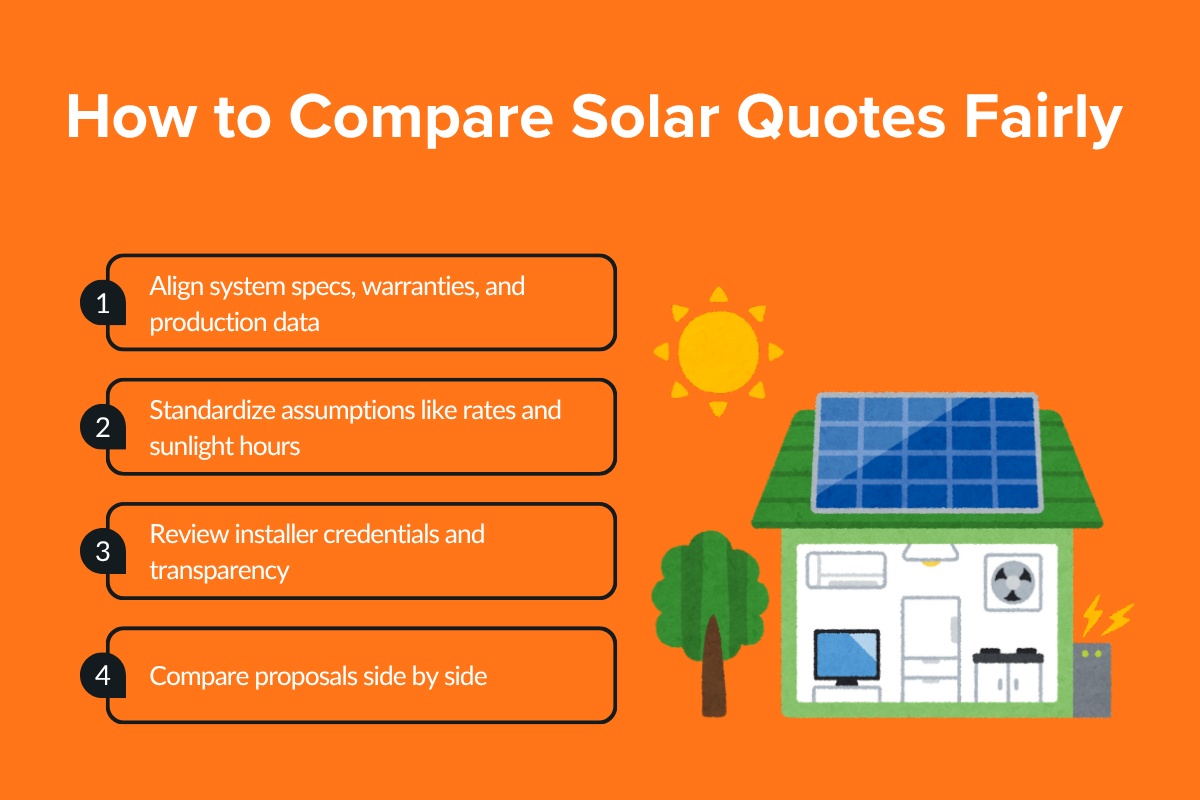
Two quotes can look similar on the surface but represent completely different systems, warranties, and assumptions. A fair comparison means isolating the variables that actually affect cost and performance, and ignoring the noise.
1. Line Up the Core Specs
Start with a clear baseline so you’re comparing like-for-like.
Check that each quote lists:
- System size (kW) and expected annual output (kWh)
- Panel and inverter brands with model numbers
- Warranties on equipment and labor
- Estimated savings and payback period
If any of these are missing, the quote isn’t complete enough for a true comparison.
2. Standardize Assumptions
Installers often use different production models or sunlight data. Ask what assumptions each quote is based on:
- Solar production data source (e.g., PVWatts, HelioScope)
- Full sun hours per year
- Local electricity rates and escalation percentage
- Degradation rate of the panels
When you standardize these inputs, you can focus on fundamental differences instead of inconsistent math.
3. Check the Fine Print
Look for small clauses that change total cost or flexibility:
- Who covers maintenance or inverter replacement?
- Are permit and interconnection fees included?
- Is there a penalty for early loan repayment or system removal?
A transparent quote will show every line item upfront, no hidden add-ons labeled “miscellaneous.”
4. Verify the Installer, Not Just the Price
The lowest number isn’t always the best value. Check:
- Certified installers (e.g., NABCEP credentials)
- Customer reviews and service ratings
- Average project timelines and support response times
Experienced solar companies may charge slightly more but save you money through better design, fewer callbacks, and smoother permitting.
5. Use a Simple Comparison Table
Create a side-by-side view to visualize key differences, eg:
| Criteria | Installer A | Installer B | Notes |
|---|---|---|---|
| System Size | 6.2 kW | 6.0 kW | |
| Panel Brand | Qcells | REC | |
| Warranty | 25 yrs | 20 yrs | |
| Estimated Savings | $X | $Y | |
| Battery / EV Charger | Optional | Included |
A clear table removes bias and helps you see which quote offers real value instead of just the lowest upfront cost.
Not sure if your solar quote is fair?
Get a clear, side-by-side comparison with Sunbase. See transparent cost breakdowns, production estimates, and incentives- all in one easy view. Start comparing quotes smarter with Sunbase today.
How to Evaluate Value Beyond the Lowest Price

Price is the first number people see and often the one that dominates their decision. But in solar, the lowest quote doesn’t always mean the best deal. Real value comes from performance, reliability, and the total cost of ownership over time.
1. Focus on Long-Term Performance
A cheaper system might save a few thousand upfront, but lose efficiency faster.
- Premium panels maintain higher output for 25+ years.
- Lower-tier hardware can degrade 1–2% faster annually, reducing lifetime returns.
Tip: Compare projected generation and degradation rates, not just total system cost, to gauge real value.
2. Assess Warranty Coverage
Warranties reflect a company's confidence in its product.
- Panel warranty: typically 25 years for performance and 10–15 years for product defects.
- Inverter warranty: usually 10–15 years, extendable with premium plans.
- Workmanship warranty: covers labor or roof penetration issues post-installation.
A quote with longer, clearly defined warranties can offset a slightly higher cost through lower maintenance risk.
3. Look at Service Quality and Support
Fast response times, project tracking, and maintenance access often separate average solar companies from great ones.
- Check customer reviews for how installers handle follow-ups and technical support.
- Transparent communication during permitting and inspections saves time and frustration later.
If a quote looks great on paper but the installer can’t commit to timelines or service standards, it’s not worth the discount.
4. Consider System Scalability
Think beyond your current needs.
- Can the system expand for future EV charging or battery storage?
- Does the inverter support add-ons or smart monitoring integrations?
Scalable systems cost a bit more but prevent expensive redesigns later as your energy use grows.
5. Weigh Brand and Installer Reputation
Established brands and certified installers typically charge more, but their consistency and proven process reduce long-term risk.
- They’re less likely to cut corners or disappear post-installation.
- They handle warranty claims and utility coordination seamlessly.
In solar, reliability compounds like returns do. The extra 5–10% you spend upfront often pays for itself through performance stability and peace of mind.
Check out: Common Mistakes in Solar Proposal Creation & How Software Fixes Them
How to Read a Solar Quote Step by Step
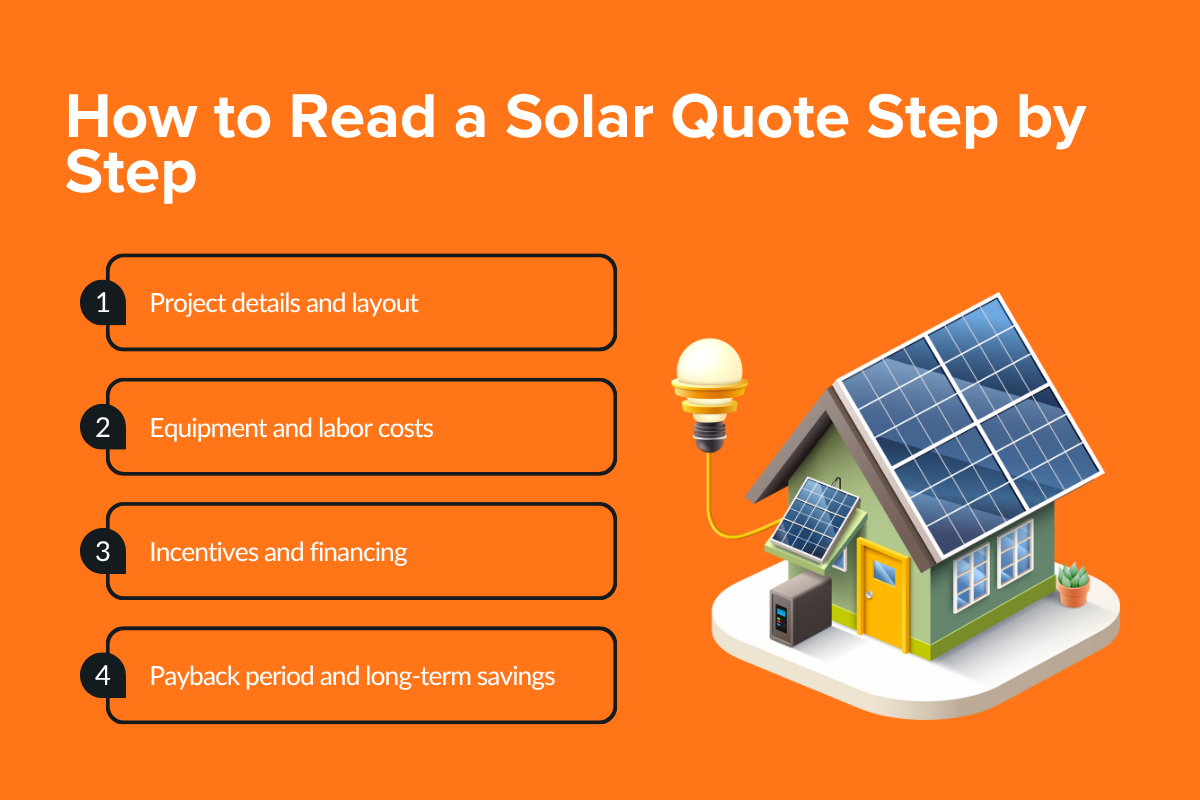
To see how everything fits together, let’s walk through a sample proposal. Below is a simplified breakdown of a rooftop solar quote, similar to what most homeowners receive.
1. Basic Project Details
- System Type: Grid-tied, 7.2 kW
- Location: Two-story home in California
- Estimated Annual Production: 10,200 kWh
- System Layout: 18 panels installed across two roof planes
This section shows the project scope: roof coverage, how many panels are proposed, and what type of system you’re getting.
2. Equipment and Labor
| Component | Description | Cost (USD) |
|---|---|---|
| Solar Panels | 18 × 400W Tier-1 modules | $8,100 |
| Inverter | 1 hybrid string inverter | $1,800 |
| Mounting + Electrical | Racking, conduit, breakers, and protection devices | $1,200 |
| Installation & Labor | Design, permits, and setup | $2,400 |
| Total Hardware & Labor | $13,500 |
This is where the main costs sit. Quotes should specify panel brands, inverter type, and warranties to ensure you know what’s being installed, not just what it costs.
3. Incentives and Financing
| Item | Value (USD) |
|---|---|
| Federal Investment Tax Credit (30%) | –$4,050 |
| Net Cost After Incentives | $9,450 |
| Financing Option | 5-year solar loan at 6.9% APR |
| Estimated Monthly Payment | $185 |
This section connects cost with your solar journey: how you’ll pay, how incentives apply, and how ownership compares to leasing.
4. Payback and Performance
- Payback Period: ~6.2 years
- Lifetime Savings (25 yrs): ~$28,000
- Modeling Assumptions: Real utility TOU rates under NEM 3.0
These projections show when your solar-installed system breaks even and starts generating pure savings.
Reliable quotes back these numbers with data from modeling tools like Aurora Solar or HelioScope.
5. Comparison Summary
If you’ve received quotes from multiple companies, align them on the same variables:
- System size (kW) and energy production (kWh)
- Hardware brand and model
- Incentive calculation and post-credit price
- Warranty coverage and service terms
This allows a transparent comparison of solar panel options rather than choosing based on sticker price alone.
6. What to Take Away
Most quotes in the U.S. follow one of two main types:
- Fixed-package quotes with preset equipment and pricing
- Custom quotes built around your home’s layout and usage
Meet Sunbase – Your Partner for Transparent Solar Quotes
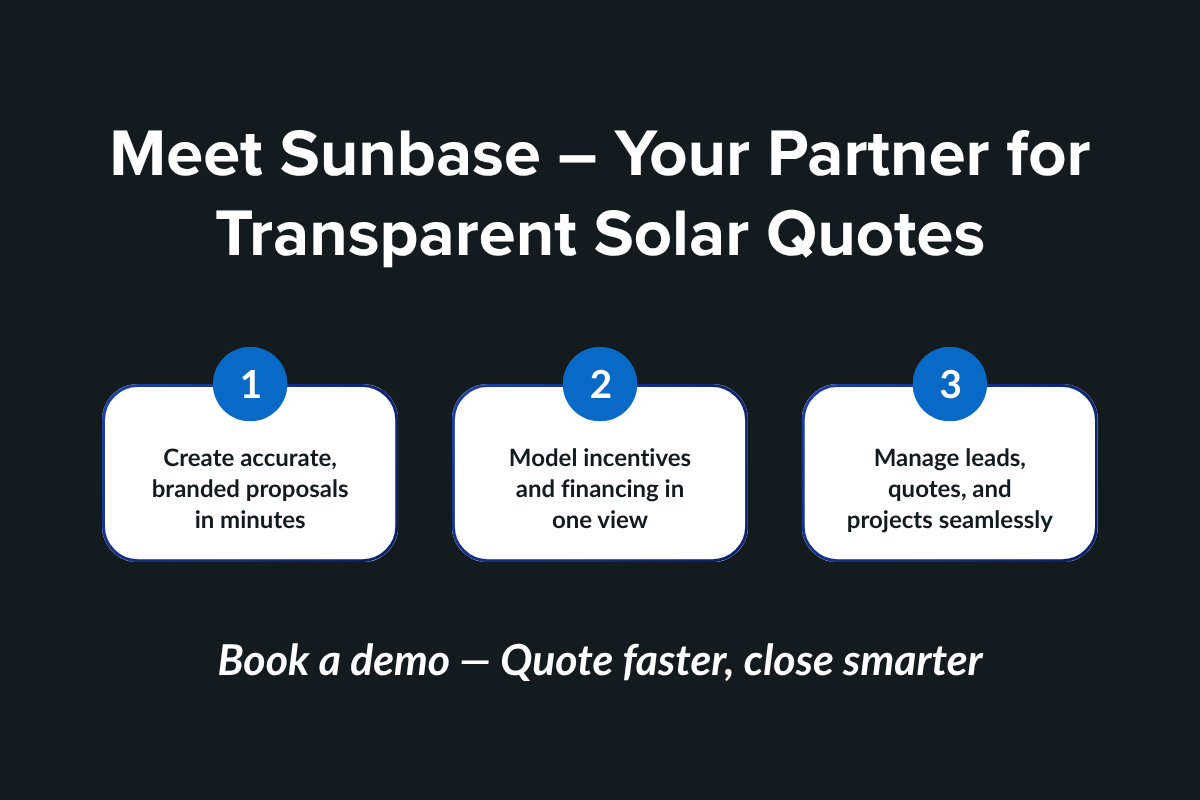
Most quoting tools focus solely on pricing. Sunbase brings everything together, helping solar businesses design, quote, and manage projects on a single connected platform.
With Sunbase, you can:
- Create professional, branded solar proposals in minutes
- Model energy production and include financing options in one view
- Perform remote site evaluations and PV system design simulations
- Manage leads, automate follow-ups, and track projects through completion
For installers, it means fewer tools to manage and faster, more accurate quoting. For customers, it means clear, consistent proposals that build trust from the first interaction.
Conclusion
A solar quote is the foundation of trust between a homeowner and an installer. When quotes are accurate, transparent, and data-driven, decisions get easier, projects move faster, and customer confidence grows.
For homeowners, clarity means control, knowing what you’re paying for and why. For solar businesses, it means consistency, professionalism, and higher close rates.
As the industry grows more competitive, transparency isn’t optional. It’s the differentiator. The companies that communicate clearly will be the ones that win.
Ready to quote with confidence?
Simplify how your team designs, prices, and delivers solar proposals, all in one place. Book a demo with Sunbase and see how transparent quoting can turn complexity into clarity for both your business and your customers.
FAQs
1. What’s included in a typical solar quote?
A standard solar quote outlines the complete project scope, including equipment (panels, inverter, mounting hardware), labor, permits, and warranties. It should also detail system size, projected energy output, and available incentives. Some installers include visuals or production models that show how your available roof space is used to achieve optimal performance.
2. Why do different installers quote different prices for the same system size?
Pricing varies because every installer factors costs differently. Brand choices, labor rates, design complexity, and financing structures all play a role.
3. How much do solar panels cost upfront?
For most U.S. homes, upfront costs range between $15,000 and $25,000 before incentives. The exact figure depends on system size, hardware selection, and regional labor rates. Federal and state tax credits can offset up to 30% or more of that total.
4. Do financing options affect total cost?
Yes. Paying upfront offers the highest return over time, while loans or leases spread payments but increase overall cost due to interest or service fees.
5. How do I know if a quote is fair?
A fair quote is itemized, transparent, and free from vague terms or hidden fees. Look for detailed breakdowns of hardware, labor, and incentives, along with clear production estimates and warranty coverage. If a proposal explains what you’re paying for in plain terms, it’s a good sign you’re working with a credible installer.
I agree to receive marketing messaging from Sunbase at the phone number provided above. I understand data rates will apply, and can reply STOP to OPT OUT.




